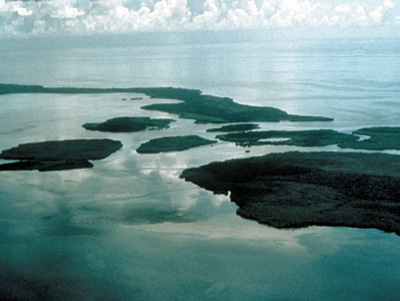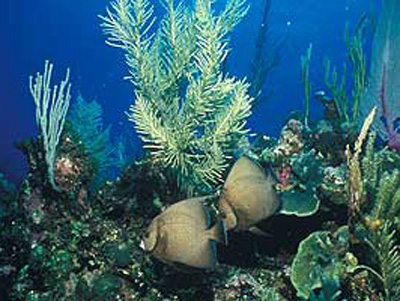
Biscayne’s natural beauty is park highlight
HOMESTEAD, Fla. — One of the most beautiful and exotic parks in the country, Biscayne National Park catches the eyes of every visitor that ventures into the park. With so much to do and so much to observe, celebrating the natural beauty of the park is essential.
“The park is absolutely stunning,” said Mike Hassel, an interpretive ranger at the park who works closely with the scientists and deals with issues surrounding humans and the ecosystem.
Biscayne’s landscape begins with the different ecosystems located throughout the park. Although they blend together creating one interchangeable environment, the terrain can be broken down into four basic territories.
We start with the mangroves, a grassy shoreline that plays an important role in habiting animals and protecting the shoreline from erosion. The mangroves form with the grassy shoreline to stretch across the edge of the water, creating a forest with greens and plants all along the shore. There are three different types of mangrove trees, with the red mangrove the rarest and most imposing of the trees.
The mangroves are home to a host of different species, from snakes to birds and spiders.
| Mangroves at the shoreline at Biscayne National Park’s Fascell Visitor Center (Photo by Harrison Raboy). |
“The mangroves acts as a nursery for the fish, cause, frankly, the bigger predators can not get to them. The mangroves are an extremely important part of our ecosystem here at Biscayne, allowing fish to grow,” said Hassel.
As the fish grow, they move to the deeper water, ready to take on the fishy challenges they might endure.
As we venture away from the mangroves, we come across Biscayne Bay, the open water portion of the ecosystem of the national park.
The water at the bay is six to eight feet deep, but is as clear and as crisp as it has ever been, and one can see the bottom of the water. With 95 percent of the park covered by water, boaters are free to roam on the bay, gazing at the mysteries of the water.
The bay hosts a magnitude of life forms, from sponges to crabs and sea plumes. Dolphins swim through the gorgeous water, providing yet another sight for visitors there just for the scenery. The largest and most unique creature that lives in the bay is the manatee, the gentle giant of Biscayne National Park.
Manatees use the grassy shorelines as a way to feed, demonstrating the way all these ecosystems are interconnected; the manatees need both the mangroves and the bay to survive. In fact, the sea grasses have adapted to saltwater and can grow in places that sunlight penetrates, creating food for the fish and other animals of the Bay.
| Biscayne Bay’s natural beauty viewed from the Visitor Center at Biscayne National Park (Photo by Harrison Raboy). |
One of the more unique features of the park is that fish are allowed to be taken out of the water, and that has created a problem with the environment. Overfishing has occurred, and most of the fish, such as trout ad grouper, are getting decimated.
“Unless you’re an excellent fisherman, you can’t really catch fish right now,” said Hassel. “We’re really working to make sure that the fish population can re-grow. We have created a tighter management schedule and changed some of the fishing hours. We don’t want to overuse this excellent resource.”
The next part of the ecosystem that Biscayne offers is the barrier reefs, an extremely beautiful part of the landscape that is instrumental to the overall health of the environment.
The reefs are very productive, supporting a large population of aquatic life.
“The biodiversity of the barrier reefs is extremely important, and is necessary for the survival of the surrounding environments,” explained Amy Elliot, a Marine biology graduate student at Nova Northeastern University.
“The barrier reefs are also very beautiful; maybe the most beautiful part of any ecosystem in the world. You can find a bevy of different species, and the health of the reefs is a good indication of the health of the ecosystem as a whole. That is why humans really need to be careful of destroying it.” Elliot said.
 |
Caesar Creek and surrounding keys of Biscayne National Park (Photo courtesy of the National Park Service). |
The reefs are constantly in danger, as humans continue to pollute the ocean. Yet, Biscayne has taken numerous steps to reverse any negative damage, such as stopping coral breeding, and using buoys instead of anchors. The park wants to keep the reefs to productive and thriving, and people and politicians are beginning to see both the appealing and economic effects.
“People have really been getting better recently with the way they are treating the reefs. I think they realize that unless they treat is well, the reefs won’t be there for their grandkids,” Hassel explained.
Barrier reefs are formed by fossilized limestone, and thousands take years to develop. The reef that Biscayne sits on is the third-largest barrier reef in the world, making it a magical and colorful sight that many observers enjoy.
The last of the ecosystems is the Keys. Elliott Key, the main key near Biscayne, lies seven miles from the land area of the park. The keys stretch for miles, creating “transitional islands – sharing some of the features of the hard rock coral keys to the south and some with the sand barrier islands to the north,” according to Biscayne’s website.
The keys have a variation of creatures, ranging from snakes to raccoons and rabbits. Because of the wet, sometimes muggy climate of the keys, insects are also an integral part, as mosquito and dragonflies buzz about.
There is plenty of plant life on the keys as well. The Web site describes everything as a “tropical hardwood hammock, surrounded by mahogany, paradise tree, gumbo limbo, satinleaf, and ironwood, tropical trees that are not found outside of South Florida within the continental United States.”
Biscayne National Park oozes biodiversity, as the park boasts more diversity than any other park in the country.
“Biscayne has more biodiversity than any other place in the world; only the rainforest has more,” said Chris Beers, a park ranger who does communication work for the park, connecting the people with the beauty of the park.
| Stunning colors of the coral reef at Biscayne National Park (Photo courtesy of the National Park Service). |  |
Biscayne has more species of fish than Yellowstone National Park has total species. And, when scientists did a quick, informal 24-hour study to see how many different types of species they could find, they found nearly 800 different types of species throughout the park.
Clearly, these two statistics show that Biscayne is brimming with biodiversity.
“The lushness and diversity of Biscayne is unmatched,” said Hassel.
The ecosystems of Biscayne are striking, full of wildlife and color. Everyone should explore the beauty.
If You Go:
Biscayne National Park
- 9700 SW 328th St., Homestead, FL 33033. Phone: 305-230-1120.
Hours of Operation:
- The Dante Fascell Visitor Center is open daily from 9 a.m. to 5 p.m.
- Convoy Point, location of the park’s headquarters and visitor center, is open daily from 7 a.m. to 5:30 p.m.
- The water portion is accessible 24 hours a day.
Things to Do:
- Take your own boat out and discover Biscayne Bay.
- Guided canoe and kayak trips offered January through April.
- Walk around the park, sightseeing, fishing, and soaking in the scenery.
- A glass-bottom boat tour-Explore the ecosystem and the mysteries of Biscayne. Call 305-230-1100 for more details… visit the website at: http://wwwbiscayneunderwater.com.

Comments are Closed